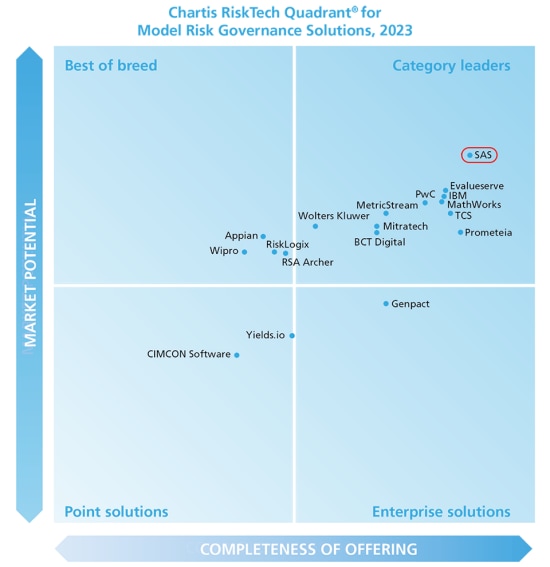10th YEAR AS A CATEGORY LEADER
Chartis names SAS a leader in both Model Risk Governance and Model Validation, 2023
SAS’s category leader position reflects a combination of features and functionality across the entire model lifecycle. SAS Model Risk Management enables users to deploy models at scale, integrate multiple data sources and support an app API-centric architecture. SAS’s position as a category leader is also supported by risk modeling visualization capabilities that support model testing/experimentation and validation process, while the ability to share parameters and integration with in-house development helps to create an efficient validation environment.
Explore More SAS Resources
To browse resources by type, select an option below.
-
- Select resource type
- Аналитический отчет
- E-Book
- Технический документ
- Технический документ
- Article
- Blog Post
- Book Excerpt
- Case Study
- Infographic
- Interview
- Research
- Series
- Video
- Вебинар
- Customer Story
- Аналитический отчет Chartis names SAS a leader in both Model Risk Governance and Model Validation, 2023.Chartis names SAS a leader in both Model Risk Governance and Model Validation, 2023.
- Технический документ Compete and win with better model risk managementAs explored in this paper, models can degrade over time, and sound model risk management (MRM) is the key to managing this risk.
- Вебинар Правильные решения в условиях кризиса: как организовать работу с аналитическими моделями в быстро меняющейся среде с помощью принципов ModelOpsНа вебинаре вы узнаете, как управлять аналитическими моделями во времена экономической нестабильности и при этом получать максимум практической пользы от внедрения технологий машинного обучения.
- Технический документ Machine Learning Model GovernanceBanks are rapidly expanding their use of machine learning-enabled (ML) models, because they can provide step-level improvements in accuracy. But ML models need even more rigorous governance than traditional models. This paper explores what's required to implement effective ML model governance.
- Технический документ Pioneering Ethical AI: The Crucial Role of Property and Casualty InsurersInsurers have long been global leaders in addressing risks and protecting people and businesses. As artificial intelligence continues to revolutionize how business gets done, it is redefining how insurers can deliver on their promises. Read this paper to learn from industry veterans and AI experts alike about: • The state of AI regulations globally. • The multifaceted role insurers can play in developing AI ethics. • Why insurers are uniquely qualified to use AI (and GenAI) – and how they’re using these technologies today. • An approach to an ethical AI framework that any insurer can follow to establish their own AI narrative.
- Технический документ Managing Models and Their RisksComputational and technological challenges present opportunities for a fast-evolving risk management discipline.
- E-Book Unifying Model Management Across the BankHow banks can empower all departments to manage model risk effectively across the entire model life cycle.
- Event Collateral Технический документ Model Risk Management: Today's Governance and Future DirectionsA GARP-SAS Survey on Model Risk in the Age of Artificial Intelligence and Machine Learning.
- Аналитический отчет Chartis RiskTech100 2024SAS climbs to No. 2 in the prestigious Chartis RiskTech 100®, 2024, and bested seven technology award categories, including AI for Banking, Behavioral Modeling and Enterprise Stress Testing.
- Вебинар Управление моделями и автоматизация процессов валидацииНестабильный рынок и модели: как быстро адаптироваться к бурно изменяющимся условиям и правильно применять свои аналитические ресурсы. Как российские компании адаптируются к новым условиям рынка, и как инструменты SAS могут помочь в этом.
- Article Model risk management: Vital to regulatory and business sustainabilitySloppy model risk management can lead to failure to gain regulatory approval for capital plans, financial loss, damage to a bank's reputation and loss of shareholder value. Learn how to improve model risk management by establishing controls and guidelines to measure and address model risk at every stage of the life cycle.
